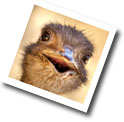 Emus are large, flightless, ostrich-like birds. They are the largest bird found in Australia and the second largest bird in the world. They are around 6 feet tall and can run at speeds of up to 30 miles per hours. Emus are large, flightless, ostrich-like birds. They are the largest bird found in Australia and the second largest bird in the world. They are around 6 feet tall and can run at speeds of up to 30 miles per hours.
Emus are found in a variety of habitats including dry plains and lightly forested woodlands. Emus have powerful legs, long necks, round heads, small wings, and shaggy gray feathers. Emus move from place to place in search of food. They eat insects, grass, leaves, berries, flowers, fruit, and seeds. The female emu lays 5-20 eggs in a nest on the ground. The male incubates the eggs for 8-10 weeks and raises the chicks. The chicks may stay with their father for up to two years. World Status Key US Status Key
Additional InformationKey: Emu - Dromaius novaehollandiae Emu - Dromaius novaehollandiae
|
|||||||||||||||||||||||||

